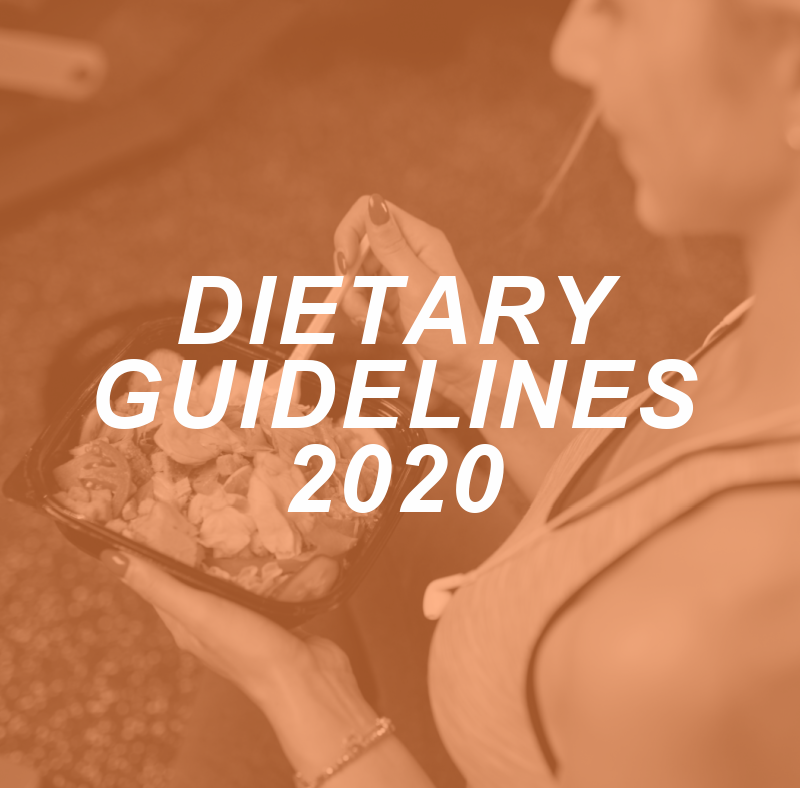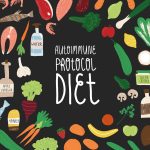
Did you know that the Dietary Guidelines for Americans (DGA) are updated by the USDA every five years? These guidelines coupled with an intimate understanding of personal training client nutrition can help personal trainers coach their clients toward their health and fitness goals. Read on for a basic grasp of nutrition physiology and the guidelines set forth by the US Government Agencies regulating and advising our dietary intake.
Nutrition 101: The Basics
Proper Caloric Intake
Many of our clients adhere to the outdated fitness advice that severely restricting calories will result in weight loss. Though an individual may lose weight for a period of time while on a starvation diet, the body will eventually respond by retaining fat and slowing the metabolism.
When a person does not ingest enough calories to meet the body’s minimum requirements for completing basic metabolic processes (basal metabolic rate), the body will perceive that it is in a state of starvation and actually retain fat, its preferred source of energy during times of survival, while catabolizing the readily accessible muscle tissue for energy.
Keep in mind that even if you are ingesting enough calories to meet these needs, you must also take into account calories expended during physical activity so that any resulting caloric deficit is not too excessive (never below basal metabolic rate).
Regular body composition testing will allow you to monitor whether muscle tissue and/or fat are being lost, gained or maintained and will guide you in making appropriate adjustments in activity and daily caloric intake.
The Standard American Diet
Most whole foods possess the necessary enzymes or the elements to produce the enzymes required in order to digest the host food. Junk food is highly-processed ingestible products and typically does not possess the enzymes or enzyme-producing elements to break down the food itself. As such, the body is charged with the task of producing the necessary enzymes (usually in the small intestine) for the digestion of the food. The energy and proteins required to produce these enzymes would be better utilized for other biological functions.
In addition, high-calorie/low-nutrient junk foods typically lack significant biochemical (vitamin) content. They also often contain saturated fats and trans fats which, due to their contribution to “bad” cholesterol levels and other potential negative health effects, are obviously undesirable.
Understanding Carbohydrates – Simple Or Complex?
Complex carbohydrates are complex chains of sugars that contain soluble fiber. As such, they are absorbed more slowly into the bloodstream. Simple carbohydrates are simple chains of sugars that do not contain soluble fiber and, as such, are more quickly absorbed into the bloodstream. This quick rate of absorption causes an over-release of insulin from the pancreas.
It is the role of insulin to remove excess sugar from the bloodstream for transport to the liver, muscle tissue, or adipose (fat) tissue for storage as energy. As the liver and muscle tissue are only able to take up this sugar (in the form of glucose) at a gradual rate, and adipose tissue is able to take it up more rapidly, it is more likely to be stored in fat cells. This potential storage as excess body fat is obviously undesirable.
Complex carbohydrates provide the body with sustained energy during regular daily activity, as well as during exercise. Whole foods such as vegetables, whole grains, legumes and fruit are sources of complex carbohydrates. Table sugar, honey cakes, cookies, and candies are sources of simple carbohydrates.
The Pros of Protein
Protein is broken down by the body into various amino acids. These amino acids are the basic building blocks for numerous biological processes, including muscle tissue remodeling, hormone synthesis, and energy provision. As it is more difficult and time-consuming for the body to digest protein, in comparison with other macronutrients carbohydrates and fat), it is a good source of energy during endurance activity and helps you feel satisfied longer after eating.
Animal sources such as lean meats, fish, and dairy products are sources of complete protein (containing all essential amino acids). Plant sources such as whole grains, vegetables, and nuts are typically sources of incomplete protein (containing some essential amino acids).
Government Nutrition Guidelines and Recommendations
These guidelines are put out by the US Department of Health and Human Services (HHS) and the US Department of Agriculture (USDA). The HHS and USDA’s role is to provide science-based recommendations on what to eat and drink in order to promote health, meet nutrient needs, and to reduce the risk of chronic disease.
The DGA provides a framework and a benchmark for fit pros, diet practitioners, health workers, and policymakers to help individuals consume a nutritionally adequate and healthy diet. The guidelines also impact federal program dietary planning for the National School Lunch Program, the Special Supplemental Nutrition Program for Women, Infants, and Children (WIC), and Supplemental Nutritional Assistance Program (SNAP).
The most recent DGAs are in effect from 2020-2025.
DGA for athletes and fit pros
The DGA and research performed around creating them indicate that the average American scores 59 out of 100 in the Healthy Eating Index (HEI). This may or may not be surprising to read. Regardless, Americans in general have plenty of room to improve that score. We as personal trainers can coach them to do so and refer them to credentialed professionals when needed.
DGA for moms and children
For the first time, DGAs include infants and toddlers from birth to 24 months of age and pregnant and lactating women. The DGA recommends the introduction of potential allergens such as eggs, cow milk, and peanuts to infants at about 6 months of age. Another recommendation for children under the age of two years is not to consume any foods containing added salt or sugar. The reasoning is that exposure to such foods so early in life tend to increase their preference for them later in life or create an affinity for it. This could potentially contribute to overweight and obesity later on in life or even in early childhood.
DGA and the Standard American Diet (SAD)
Unfortunately, most Americans consume what is often referred to as “The Standard American Diet (SAD).” This means processed foods rich in salt, sugar, and unhealthy fats that are calorie-dense over more nutritious choices such as fruits, vegetables, whole grains, nuts, legumes, seeds, lean meat, and other nutrient dense food choices (defined by the DGA as providing “vitamins, minerals, and other health-promoting components and have little added sugars, saturated fat, and sodium. Vegetables, fruits, whole grains, seafood, eggs, beans, peas, and lentils, unsalted nuts and seeds, fat-free and low-fat dairy products, and lean meats and poultry—when prepared with no or little added sugars, saturated fat, and sodium— are nutrient-dense foods.”).
DGA and Culture
The new DGA also take culture into consideration and encourage ‘trades’ and ‘swaps.’ Should a person be eating a SAD, the DGA encourages swapping foods such as conventional ice cream with homemade avocado ice cream or banana ice cream. Should the person eat foods that have originated from countries other than America or are classified differently, the DGA also provides substitutions for those. The key is not necessarily what culture the food is from. Processed foods that are calorie-dense abound and the DGA encourages making healthier substitutions for such choices.
DGA and Sugar
There was much debate on whether or not to lower the recommended amount of daily sugar intake or not in the most recent set of DGA’s. The 2020-2025 DGA didn’t do it. The HHS and USDA considered and reviewed the Scientific Report of the 2020 Dietary Guidelines Advisory Committee and public comment and after the review and considerations, left the recommendation that added sugar remain less than 10% of an individual’s daily caloric intake. They were considering lowering it to 6%. The main culprit or top source of added sugar in the American Diet is attributed to sugar-sweetened beverages.
There are several documented consequences to the overconsumption of added sugar. Research shows that sugar-sweetened beverages increase the risk of fatty liver disease and high blood pressure (HBP). The other risk of consuming too much added sugar is that it contributes to obesity thereby also increasing the risk of heart disease. Sugar also impacts insulin responses in the human body and diabetes.
One healthy swap from sugar-laden beverages is water for hydration or electrolytes or water with cucumber/fruit at the bottom for taste and is a top priority to advising personal training client nutrition.
DGA and saturated fat:
The recommendation is to limit saturated fat to less than 10 percent of daily caloric intake per day starting at 2 years of age.
DGA and sodium:
The recommendation is to limit sodium to less than 2,300 mg per day starting 2 years of age (that’s approximately one teaspoon of salt).
DGA and protein:
The consumption of lean sources of protein is emphasized, pointing out that a majority of older Americans do not consume an adequate amount of protein, while 50% of women and 30% of men do not consume enough. Your guidance as a fitness professional will be tantamount to affecting your clients’ perspective and ultimately habits with regard to adequate protein intake, especially when coupled with a muscle-building exercise program. This is where your expertise as a personal trainer will come into play and you may have to delve deeper into the topic of macronutrient distribution in the diet.
DGA and alcohol:
The recommendation is to limit alcoholic beverages to 1 drink or less per day for women and 2 drinks per day or less for men.
One drink is defined as 12 fluid ounces of beer, 5 fluid ounces of wine, or 1.5 fluid ounces of 80-proof liquor like vodka or rum.
DGA in action
Along with the release of the 2020-2025 DGA came the “Make Every Bite Count” Campaign. This campaign includes four calls to action with regard to optimal nutrition:
1) Follow a healthy dietary way of eating at every life stage.
2) Limit foods and beverages higher in added sugars, saturated fat, and sodium while also limiting alcoholic beverages.
3) Enjoy and customize nutrient-dense food and beverage choices to reflect cultural traditions, personal preferences, and financial situations (budget).
4) Focus on meeting the needs of the major food groups with nutrient-dense foods and beverages and stay within daily caloric intake limits.
Personal Training Client Nutrition Guidance
The 2020-2025 Dietary Guidelines for Americans could be utilized by personal trainers as an amazing resource to start conversations about healthy eating with clients or serve as a guide to answer their questions regarding nutrition. They can be especially beneficial when working with children or clients with children under 2 years of age since this is an area that is really emphasized by the DGA.
Essentially, establishing healthy eating habits early in life increases the likelihood of maintaining them in later years. This, in turn, lowers the risk of developing obesity and other related illnesses. However, it’s good to start eating more nutrient-dense foods no matter what age or stage of life. Personal training client nutrition planning and guidance work synergistically with the fitness programming you work hard to plan; one cannot be successfully achieved without the other.
Consider this: if the research indicates that the majority of Americans are not making the healthiest food choices on a regular basis, it’s important to address it with clients. Not only can their overall health improve by eating nutrient-dense foods on a regular basis, so can their athletic performance during sessions and/or in whatever activities they participate in.
References
https://www.dietaryguidelines.gov/sites/default/files/2020-12/Dietary_Guidelines_for_Americans_2020-2025.pdf
https://www.dietaryguidelines.gov/
https://health.gov/news/202012/usda-and-hhs-just-released-dietary-guidelines-americans-2020







